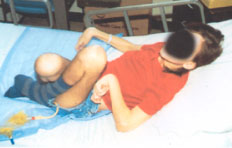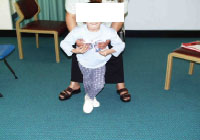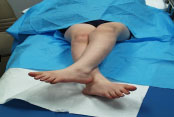| 1. Equinovarus
กล้ามเนื้อมัดที่มีการหดเกร็งได้แก่ tibialis anterior, tibialis posterior,
long toe flexors, medial and lateral gastrocnemius, soleus, extensor hallucis
longus, peroneus longus
พบบ่อยที่สุดมักพบ toe curling หรือ toe clawing ร่วมด้วย เมื่อนอนหรือนั่งด้านขวาของเท้าจะเสียดสีกับ เบาะ ขอบเตียง พื้น foot pedal ของ wheelchair ทำให้เกิดแผลถลอกที่ fifth metatarsal head ในช่วง stance phase พบว่า forefoot จะแตะพื้นก่อน น้ำหนักจะตกที่ด้านข้างของเท้าและมีนิ้วเท้างอจิก ผู้ป่วยจะปวดที่ fifth metatarsal head เมื่อเดินลง น้ำหนัก |
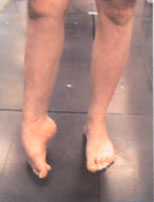 |
| 2. Valgus foot กล้ามเนื้อที่มีการหดเกร็ง
ได้แก่ peroneus longus และ peroneus brevis gastrocnemius soleus
อาจพบ toe flexion ร่วมด้วย ผู้ป่วยจะปวดที่ medial border of foot |
|
| 3. Striatal Toe หรือ Hitchhiker's Great Toe
กล้ามเนื้อที่มีการหดเกร็งคือ extensor hallucis longus (EHL) มีการกระดกขึ้นของ great toe เหมือน positive Babinski response ผู้ป่วยจะมีปัญหาในการใส่รองเท้า ปวดที่ปลายนิ้วและใต้ first metatarsal head ขณะ stance phase |
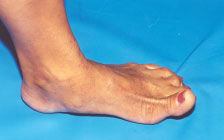 |
| 4. Stiff Knee กล้ามเนื้อมัดที่มีการหดเกร็งได้แก่
iliopsoas, gluteus maximus, rectus femoris,vastus
intermedius, vastus medialis, vastus lateralis, hamstings ผู้ป่วยจะนั่งเก้าอี้หรือรถเข็นโดยงอเข่าไม่ได้ ทำให้ขา เหยียดออกไปตลอดเวลา และปัญหาช่วง swing phase ขณะเดินผู้ป่วยจะ compensate โดย ipsilateral circumduction, hiking of the pelvis, contralateral vaulting มีการใช้พลังงานในการเดินมากขึ้น |
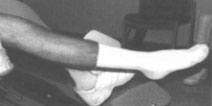 |
| 5. The Flexed Knee กล้ามเนื้อมัดที่มีการหดเกร็ง
ได้แก่ medial and lateral hamstrings และ guadriceps มีปัญหาช่วง swing phase ผู้ป่วยจะ compensate โดย ipsilateral hip flexion and contralateral hip and knee flexion (crouch gait pattern) |
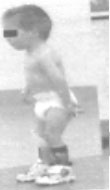 |
